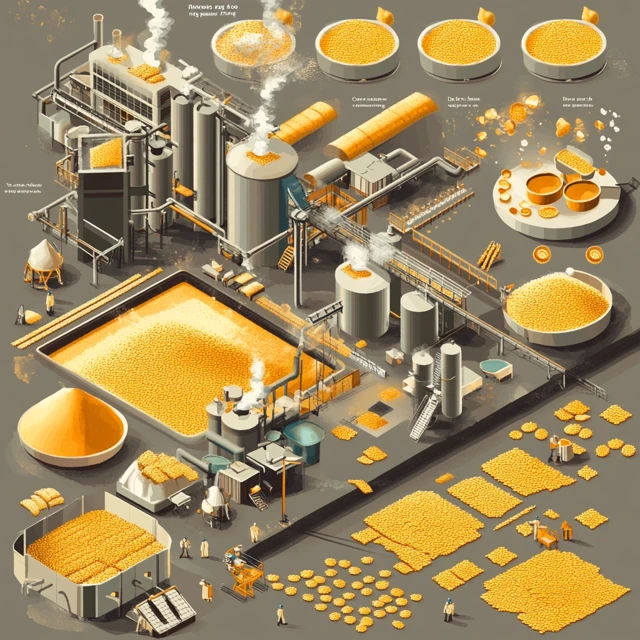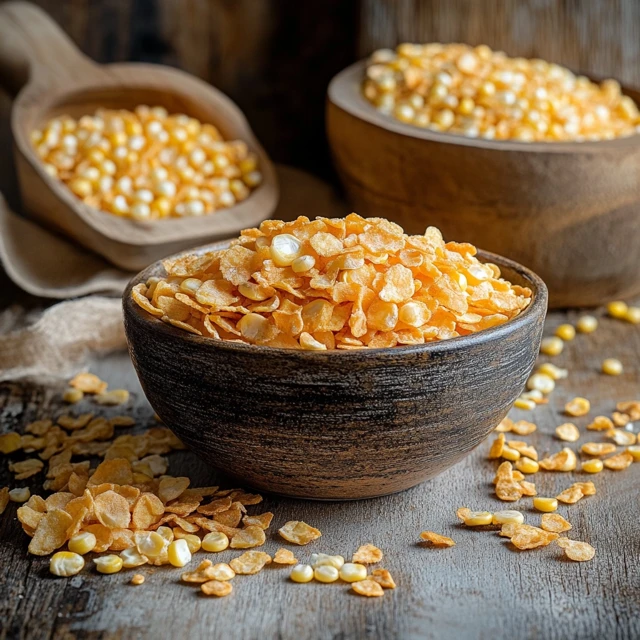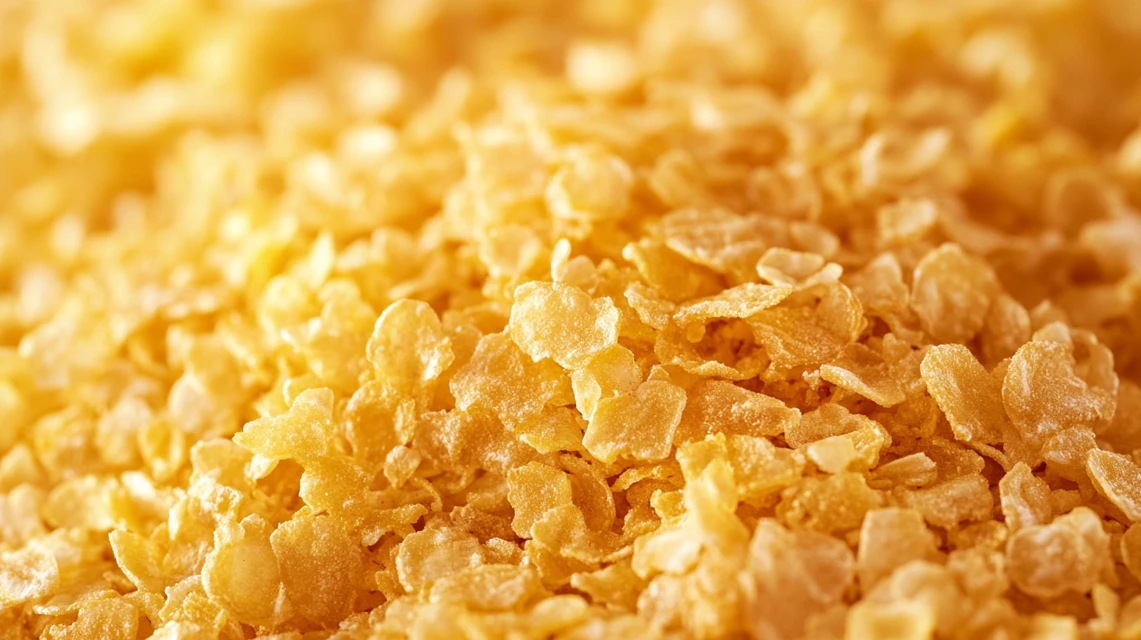Corn flakes are a breakfast favorite known for their light, crispy texture and versatility. But have you ever wondered what exactly goes into making them? From simple ingredients to a carefully designed production process, corn flakes are a result of science, nutrition, and innovation.
The Main Ingredients of Corn Flakes
A few simple ingredients form the foundation of corn flakes, and together they create the cereal’s distinctive taste, texture, and nutritional value. Therefore, let’s examine each ingredient to understand its unique contribution.
Corn as the Primary Ingredient
The foundation of corn flakes is, as the name suggests, corn. Specifically, they are made from milled corn, which is derived from dried corn kernels. These kernels undergo processing to create the thin, flaked texture that defines corn flakes. Corn serves as the primary source of carbohydrates, making it a key component of this breakfast staple.
Why corn? It’s readily available, affordable, and provides a neutral flavor that pairs well with a variety of toppings and additions. Corn also contributes to the light, crunchy texture that makes corn flakes so enjoyable.
Role of Malt Flavoring and Sugar
To enhance the flavor, many brands add a small amount of malt flavoring and sugar during production. Malt flavoring is derived from barley or other grains and adds a slightly sweet, nutty taste. Sugar, used in minimal quantities, helps balance the natural flavors of the corn and improves the overall taste.
However, the amount of sugar in plain corn flakes is relatively low—typically around 2-3 grams per serving. For sweetened varieties, such as frosted flakes, the sugar content is significantly higher.
Fortification with Vitamins and Minerals
Many corn flakes are fortified with essential vitamins and minerals to boost their nutritional value. These added nutrients make corn flakes a more balanced choice for breakfast, especially for individuals who may need to fill specific nutritional gaps. Common fortifications include:
- Iron: Supports red blood cell production.
- Vitamin D: Aids in calcium absorption for strong bones.
- B Vitamins (B1, B2, B3): Help with energy metabolism and overall health.
This fortification process ensures that corn flakes offer more than just carbohydrates, providing a well-rounded option for busy mornings.
The Production Process of Corn Flakes
The journey of corn flakes from corn kernels to your breakfast bowl is a fascinating process. Each step is carefully designed to ensure the crispy, golden flakes you know and love.
Cleaning and Preparing the Corn
Manufacturers begin making corn flakes by sourcing high-quality corn. First, they thoroughly clean the corn kernels to eliminate impurities like dirt, husks, and stones. Through this careful cleaning process, they ensure only the finest kernels move forward into production.
After cleaning, workers steep the kernels in water to soften them. Consequently, this softening step prepares the corn for cooking, and thus makes it easier for the team to handle and transform the kernels into flakes.
Cooking and Rolling the Corn Kernels

After soaking, the corn is cooked under controlled pressure and heat. This cooking process breaks down the tough outer layer of the kernels and softens the inner starches. The result is a pliable, dough-like material that can be shaped into flakes.
The cooked corn is then flattened into thin sheets using heavy rollers. These rollers compress the corn into the desired flake shape, ensuring uniform thickness for consistent toasting later in the process.
check out this https://eassyrecipes.com/category/breakfast/
Toasting for Flavor and Crunch
The final step in making corn flakes is toasting. The thin, rolled flakes are passed through a large toasting oven, where they are exposed to precise temperatures. This step:
- Removes excess moisture, ensuring a crispy texture.
- Gives the flakes their signature golden-brown color.
- Enhances the natural flavors of the corn.
The toasting process is what transforms the simple corn kernels into the light, crunchy corn flakes we enjoy for breakfast.
Are There Variations in Ingredients?
When it comes to corn flakes, not all products are the same. Over the years, manufacturers have introduced variations to meet the needs of different diets and preferences. From gluten-free options to organic and sweetened varieties, these innovations ensure that there’s a type of corn flakes for everyone.
Gluten-Free Corn Flakes
Traditional corn flakes contain primarily corn. However, manufacturers typically add malt flavoring derived from barley, which in turn contains gluten. As a result, people with celiac disease or gluten sensitivity need to exercise caution. Fortunately, many brands now…offer gluten-free corn flakes.
Key features of gluten-free corn flakes:
- Malt-Free Formulas: Instead of using barley-based malt flavoring, gluten-free versions often use alternative flavoring agents to maintain the taste.
- Certified Gluten-Free Labels: Look for certifications on the packaging to ensure the product is free from gluten contamination.
- Accessible to All: These options make corn flakes a viable breakfast choice for individuals who must strictly avoid gluten.
Gluten-free corn flakes have become widely available in most grocery stores, offering a safe and delicious option for those with dietary restrictions.
Organic and Non-GMO Options
With the growing demand for natural and sustainable foods, manufacturers have introduced organic and non-GMO corn flakes. These variations cater to consumers who prioritize clean eating and environmental consciousness.
Key benefits of organic and non-GMO cornflakes:
- Organic Certification: Organic cornflakes are made from corn grown without synthetic pesticides or fertilizers. This ensures that the ingredients are free from harmful chemicals.
- Non-GMO Assurance: Non-GMO options are produced using corn that hasn’t been genetically modified, appealing to those who avoid genetically engineered foods.
- Minimal Additives: Many organic varieties avoid artificial flavors, preservatives, and colors, offering a more natural product.
While these versions may cost slightly more, they provide peace of mind for health-conscious individuals and those committed to sustainable agriculture.
Sweetened vs. Unsweetened Corn Flakes

One of the most noticeable variations in cornflakes is the choice between sweetened and unsweetened varieties. These differences cater to varying taste preferences and dietary goals.
- Unsweetened Corn Flakes:
- Contain only 2-3 grams of sugar per serving, making them a low-sugar option.
- Preferred by those watching their sugar intake or looking for a neutral flavor that pairs well with a variety of toppings.
- Often fortified with vitamins and minerals, offering a balanced choice for breakfast.
- Sweetened Corn Flakes:
- Include added sugars, honey, or flavored coatings, resulting in 6-12 grams of sugar per serving, depending on the brand.
- Popular among children or those who enjoy a sweeter taste without additional toppings.
- Common examples include frosted flakes or chocolate-flavored cornflakes.
When choosing between sweetened and unsweetened cornflakes, it’s essential to consider your dietary needs and how the cereal fits into your overall meal plan. Unsweetened options offer greater flexibility, allowing you to control the sweetness by adding natural toppings like fruit.
check out this https://eassyrecipes.com/category/breakfast/
FAQs About Corn Flakes Ingredients
Corn flakes stand as a household name in breakfast cereals. Nevertheless, countless people still wonder about their ingredients and how they fit into different lifestyles. Therefore, let’s explore and answer the most common questions about cornflakes and what goes into making them.
Are Cornflakes Actually Made of Corn?
Manufacturers primarily use corn to make cornflakes. First, they mill dried corn kernels to create the foundation of this cereal, since these kernels provide the essential carbohydrate base.
Next, the production team thoroughly cleans and prepares the corn kernels. After that, they cook, roll, and finally toast the corn into thin, crispy flakes. Although corn serves as the main ingredient, manufacturers additionally incorporate small amounts of sugar, malt flavoring, and salt to enhance the taste.
How Are Corn Flakes Made?
The process of making cornflakes involves several carefully designed steps:
- Here’s how companies make cornflakes, step by step! First of all, they start by cleaning all the dirt and tiny bits off the corn kernels. After that, they put the clean corn in a special cooker with high pressure until it gets nice and soft, which makes it easier to work with. Next comes the exciting part – big rollers squish the soft corn into those flat flakes we all recognize. Finally, they pop these flakes into a hot oven to toast them. So what happens in the oven? The heat makes the flakes super crunchy, gives them that yummy taste, and turns them into that beautiful golden color we see in our bowls!
This process is straightforward yet precise, ensuring consistent quality and flavor in every box of cornflakes.
check out this https://eassyrecipes.com/category/breakfast/
What Do Corn Flakes Contain?
Corn flakes are made of a few simple ingredients, but they may vary slightly depending on the brand and type. The basic components include:
- Corn: The primary ingredient, serving as the base of the cereal.
- Sugar: Added in small amounts to enhance flavor. Unsweetened varieties contain very little, while sweetened versions may have significantly more.
- Malt Flavoring: Provides a slightly nutty and sweet taste. This ingredient is often derived from barley and may contain gluten.
- Salt: Adds balance to the flavor profile.
- Vitamins and Minerals: Many cornflakes are fortified with nutrients such as iron, vitamin D, and B vitamins, which boost their nutritional value.
It’s always a good idea to check the ingredient label for specific details, especially if you’re avoiding added sugars or gluten.
Why Do Bodybuilders Eat Corn Flakes?
Bodybuilders often include cornflakes in their diet because they are a quick and convenient source of carbohydrates. Here’s why they are popular among fitness enthusiasts:
- Easily Digestible: Cornflakes are light on the stomach, making them an excellent choice for pre- or post-workout meals.
- Quick Energy Source: Here’s what happens when you eat cornflakes! Your body breaks them down really fast, so you get quick energy. That’s why they work great after a hard workout. This quick energy boost can help you feel better after exercising!
- Versatile Meal Option: Bodybuilders can pair cornflakes with protein-rich additions like milk, yogurt, or whey protein to create a balanced meal that supports muscle recovery and growth.
- Convenient and Affordable: Compared to other carbohydrate sources, cornflakes are cost-effective and easy to prepare.
Though cornflakes alone don’t make a full meal, you can easily mix them with other healthy foods to help meet your bodybuilding needs. Their simple makeup and many ways to eat them make them a helpful part of a bodybuilder’s food plan.
Conclusion
Here’s how we make cornflakes! First, companies start with simple things like corn, sugar, and malt for flavor. Plus, they often add extra vitamins and minerals to make them healthier. Then comes the fun part – they clean the corn really well, cook it up, and roll it flat. Finally, they toast the corn until it turns into those crunchy flakes we love to eat for breakfast.
So why do people love cornflakes? First, they’re super easy to make when you’re in a hurry. Plus, athletes like them because they give quick energy. And since they work for lots of different diets, many people can enjoy them. Now that you know what’s in cornflakes and how companies make them, you can decide the best way to fit them into your daily meals!
Whether you’re choosing plain cornflakes for a low-sugar option, exploring gluten-free varieties, or pairing them with protein for a post-workout boost, cornflakes remain a versatile and beloved breakfast staple.

